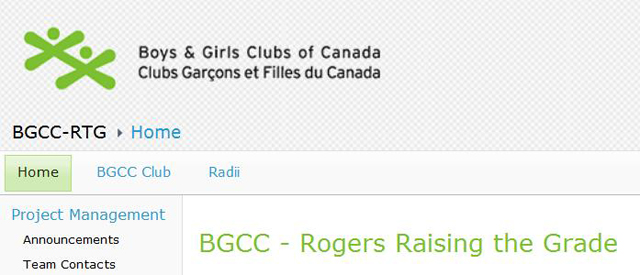November 30, 2012 by radii

The next level of project confidence is all about good communication and the right tools.
For the Rogers Raising the Grade initiative by the Boys and Girls Clubs of Canada, a nationwide program focused on helping youth achieve more in school, good communication wasn’t just a necessity for good project management—it was vital to the success of the project. So when we were brought in to develop the tools needed, we knew that a communications-optimized SharePoint implementation would be the ideal solution.
Because of the nature of a national program headed by multiple teams in various locations, good communication would be founded on a straightforward organizational structure that would provide a clear flow for teams to work with one another. It would also be crucial to ensure the teams could easily access the information they would need most frequently and then work without any unnecessary distractions. Likewise, because SharePoint can be such a massive application, it needed to be developed in such a manner so that it wouldn’t become another time-consuming and complicated task in the midst of the project.
Continue Reading

Although at first glance Microsoft SharePoint seems like it would mostly benefit large businesses that deal with a number of internal and external department, many small businesses see substaintial gains in terms of productivity and project efficiency through SharePoint. When taking into account the improvement in overall workflow, the costs are generally negated--if the free version of the software (WSS) doesn't suffice and additional customization and add-ons are required (as is usually the case).
Regardless of which version of SharePoint is implemented (there are several suitable to different structures), its benefits shouldn't be overlooked by small businesses. Here are three ways SharePoint can revolutionize the way your small business works--for the better.
Continue Reading

It's human nature that we're interested in the latest and greatest, attracted to recent fads, fashions and subsequent faux pas like red ink edits on the first round of web copy--we're all over it. Especially in the web production industry, trends can be a powerful current. The larger the stream, the more the entire river changes its course.
Watching trends isn't just for those trying to keep up with the Jones--it's also an invaluable metric for understanding the larger economics at play. When the Web 2.0 look developed, why did glossy, beveled edges and reflections dominate new design? The ease-of-use created by CSS3 has opened the web up to new possibilities. And large footers with sub-menus? New SEO algorithms and a shifting importance on User Accessibility directed designers towards revising traditional elements. We're quite guilty of experimenting with a number of the latest trends ourselves; there's nothing wrong with a fad as long as it doesn't compromise the accessibility of the content. Ultimately, the important take-away from web trends isn't so much about aesthetics as it is about the future of the web and the way we use it.
For this reason, we decided to break this topic up into two categories. Trends generally refers to aesthetic treatments or ways of interacting with content, while evolution refers to bigger picture ideas about the way this industry is progressing. In general, there seems to be a stronger focus now more than ever on content on the web. The driving force behind this is that content publishers (authors, bloggers, designers, developers, etc.) now have so little control over how their content is going to be accessed. People might view it on their 2G feature phone, their new iPad 3, their 27" Thunderbolt display, a stripped down version via an RSS reader, Instapaper or Readability, or on a 60" TV through their Nintendo Wii browser. Web designers are being challenged to not only contend with tides of technology, but ride the digital wave as well.
Here's the six most prevalent trends we've encountered in 2012 thus far, along with a run through of six evolutions we expect to continue to shape the face of the web.
Continue Reading

When you consider the vast (and ever growing) field that development is, it’s easy to see why it can be a daunting career choice. Covering everything from programming to front-end, our developers are all specialists in their own field—development is an increasingly varied industry. And for this industry, this is really only the beginning.
So where do you begin? Here’s the first ten things you should know when learning to code and starting out in the industry.
Continue Reading




